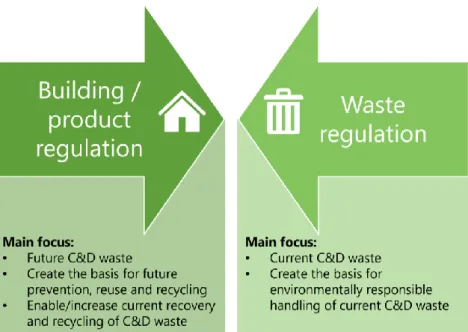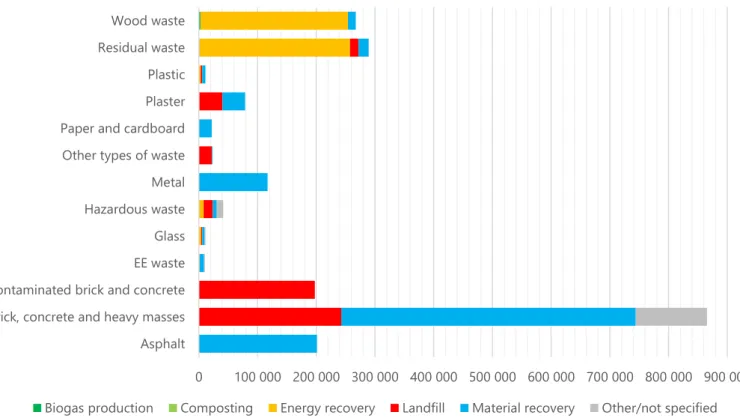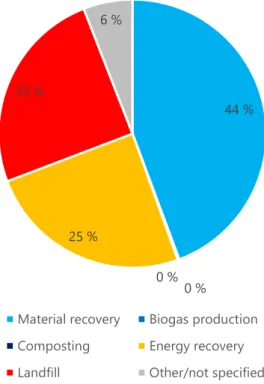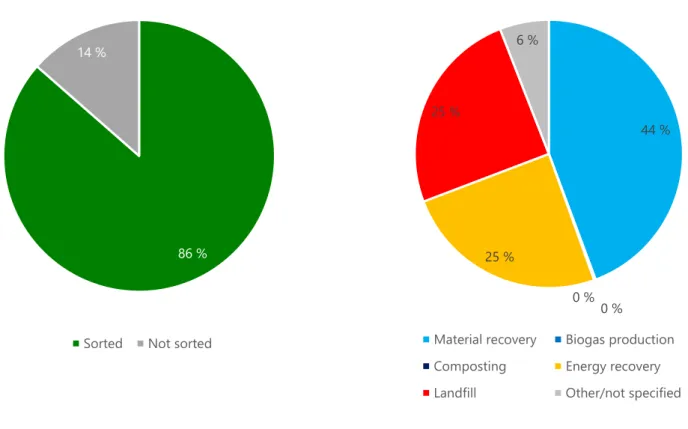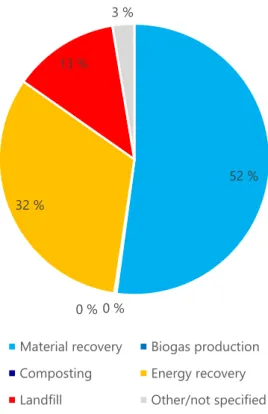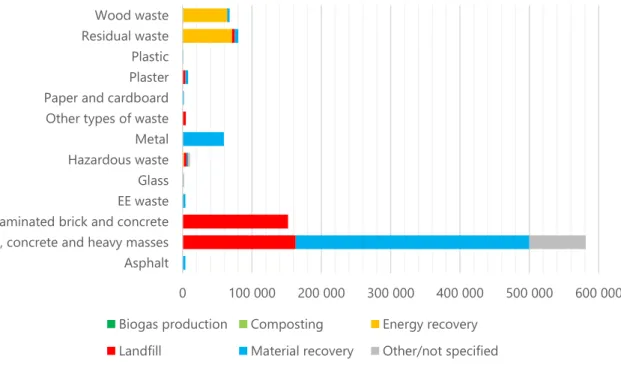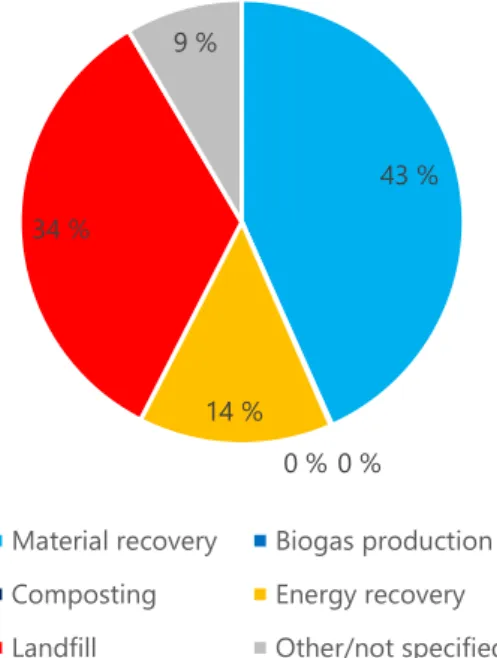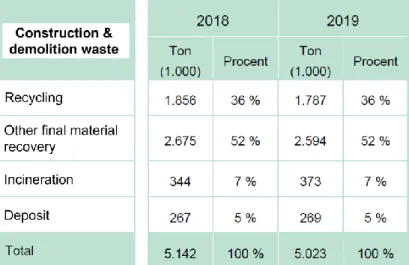Introduction
Executive summary
In short, all studied political initiatives and legislation will have a positive effect on the overall material recovery rate in Norway. NIRAS carried out a scenario to illustrate possible effects on waste generation and material recycling rate if a set of initiatives were implemented.
Definitions
Responsible designer: Is responsible for ensuring that the building or construction is designed in accordance with the regulation. The designer is responsible for documenting the conditions and solutions that form the basis of the design.
Method
- Collection of available statistics, policies and strategies
- Interviews with Norwegian stakeholders
- Interviews with European stakeholders
- Literature study
- Deeper look into Denmark
The Danish C&D waste research describes the handling of construction and demolition waste in Denmark with a focus on statistical data, legislation, barriers, drivers and best practices related to increasing prevention, reuse or recycling.
EU legislation and targets
- Waste Framework Directive (WFD)
- Landfill Directive
- Eco Design Directive
- Construction Products Regulation (CPR)
- Energy Performance of Buildings Directive
- Renovation wave
- EU Construction and Demolition Waste Management Protocol
The Landfill Directive supports Member States in introducing initiatives to place construction and demolition waste in the waste hierarchy and in the revision of the WFD by the Commission. In order to improve the circularity of construction products, in line with the objectives of the Circular Economy Action Plan, manufacturers should favor the reuse, remanufacturing and recycling of their products.
Norwegian legislation and initiatives
- The Pollution Control Act (Forurensningsloven)
- The Planning and Building Act
- Regulations on technical requirements for construction works (Byggteknisk forskrift (TEK17))
- Regulations relating to Building Application (Byggesaksforskriften (SAK 10))
- Regulation on safety, health and the working environment on building or construction sites
- The Regulation on Recycling and Treatment of Waste (Avfallsforskriften)
- The national Waste management plan for 2020-2025
- Norwegian Green Building Council (Grønn Byggallianse)
The final report on the actual waste management must be included in the completion certificate application. The current waste management plan is a review and update of the 2013 waste strategy with annexes.
Danish legislation and initiatives
Waste regulation
For construction, general waste management requirements for commercial operators also include construction and demolition waste from construction sites. In addition, it is a requirement that the sorting and post-treatment of construction and demolition waste takes place in such a way that the separation of materials that cannot be treated in the same way (throughout the entire logistics or value chain) is guaranteed. There is no trivial limit on when construction and demolition waste can be considered sorted, but when determining the sorting obligation, the principle of proportionality should be taken into account when assessing the degree of sorting.
C&D waste that is slightly contaminated with PCBs can be recovered (other material recovery) under certain conditions without a permit, but after prior notification to the municipality. However, in our experience, very few (if any) builders/contractors use the lightly PCB contaminated C&D waste due to fear of potential future liabilities and risks.
Building regulations and product regulations
However, from 2023 sustainability will become a theme in the regulations, with requirements set for maximum CO2 emissions during the life of a building. The ambition of the sustainability class is to define and offer an accessible and uniform basis for sustainable construction. The purpose of the sustainability class is to embrace the three dimensions of sustainable building: ecological, social and economic quality.
The class, which contains the requirements for LCA calculations for new buildings, will now be tested for a period of two years and is then intended to be implemented in the Danish building regulations.9. Selective demolition is demolition where materials from a building are separated and sorted in order to achieve maximum utilization of the materials.
Other initiatives
The requirement will be introduced in the building regulations in the same way as the building regulations' other technical requirements. ENV1.1 on life cycle assessment (LCA) of the building materials and the building's environmental impacts. There are a number of projects and collaborations within the construction sector that aim to enable increased waste prevention, reuse and recycling, e.g.
Værdibyg (Value Build) is a collaborative development program that includes trade unions and industry associations within the building sector. The program identifies and develops best practices for the building process through workshops, dialogues and studies.
Standardisation in Europe or Norway
Statistics
C&D waste statistics, Norway
As shown in figure 3, the C&D waste in Norway in 2020 (including new construction, renovation and demolition waste) is dominated by brick and concrete, followed by residual waste, wood, asphalt and contaminated brick and concrete. 31/59 Figure 41: The pie charts show C&D waste from building and construction projects in 2020, excluding hazardous waste. 33/59 Figure 6: The pie charts show C&D waste from new construction of building and construction projects in 2020, excluding hazardous waste.
The amount of waste material recycled is also lower; 36 % compared to 44 % in all C&D waste. 35/59 Figure 8: The pie charts show C&D waste from renovation projects of building and construction projects in 2020, excluding hazardous waste.
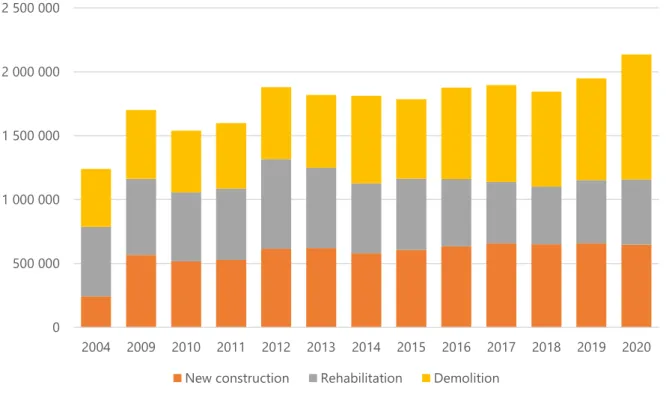
C&D waste statistics, Denmark
The pie chart on the left shows sorted and unsorted waste, while the pie chart on the right shows the distribution of treatment methods of the waste. However, it is widely recognized that the official waste statistics are quite inaccurate and that actual amounts of C&D waste are much higher due to the fact that much waste is not correctly weighed or registered. The significant difference between the two figures can either be due to the fact that some of the bricks and concrete are not classified as waste (and therefore do not need to be reported), or that the reporting does not take place. 27.
According to the Danish Environmental Protection Agency's waste statistics, 36% of C&D waste is being recycled, while 52% is recovered, including concrete waste fill, 7% incinerated with energy recovery and 5% landfilled. Mixed C&D waste is sent to sorting which results in a higher overall recycling rate for C&D waste.
C&D waste statistics, EU member states
Prior to 2018, there was no distinction between "recycling" and "recovery (other)" in waste statistics as both types of utilization were categorized as "recycling"28, resulting in higher recycling rates. Note: The use of different terms such as "other recovery" and "final material recovery" clearly indicate the challenges in comparing statistics between countries. 39/59 practices reveal that the recovery of C&D waste is mainly based on low-level backfilling and recovery operations, such as the use of recycled aggregates in road sub-bases (European Environment Agency, 2021).
However, NIRAS has not been able to identify why the differences in material recovery reported by SSB and Eurostat occur. The European Commission has created a website with information on policy initiatives, regulations and country fact sheets on C&D waste management in all member states.
![Figure 31: Recovery rate of construction and demolition waste [CEI_WM040] last updated 04.01.2022](https://thumb-eu.123doks.com/thumbv2/9pdfnet/19306489.0/39.892.92.799.193.598/figure-recovery-rate-construction-demolition-waste-cei-updated.webp)
Possible explanation for a level of 44 % material recovery in Norway
- The reliability and comparability of statistics
- C&D waste composition is different from average EU
- Regulation on use of concrete for material recovery, including backfilling
- Market for secondary products – bricks, concrete
- Lack of recycling requirements in Norwegian legislation
Consequently, the amount of wood waste will make it more difficult to achieve the overall material recycling target in the WFD. Compared to Denmark, the composition of some heavy C&D waste has significant differences in the statistics. In Denmark and the Netherlands, requirements in legislation for construction and demolition are followed by requirements for the waste treatment laid down in the waste regulation.
The requirements for source separation of waste at construction sites presented in the Regulation on technical requirements for construction works are in the Norwegian regulation, followed by the requirement for waste treatment itself. The Norwegian requirements in the regulations for technical requirements for construction works should be followed by the requirements for material recovery in the waste regulations.
Effects of new EU regulation on C&D waste treatment
Initiatives for waste prevention – effects on C&D waste generation
Material recovery is just one of many indicators to achieve the political visions presented in the strategy. Therefore, reduced waste volumes should result in a demand for a higher proportion of concrete waste for backfilling purposes (although the recovery rate of the material will still be hampered by challenges related to possible chromium 6 leaching, etc.). For wood waste, material recovery is generally low, and waste prevention will have a positive effect on the material recovery rate.
Therefore, NIRAS argued that there are reasons to believe that the above waste prevention measures will also have a positive effect on the material recycling rate for construction waste. For metals and paper/cardboard, waste prevention will result in lower material recycling rates, as these materials are more or less always recycled.
EU initiatives for source separation and material recovery
Costs associated with transportation are a barrier to recycling, as landfill may be the most economically desirable option for gypsum waste produced at construction sites far away from these facilities. Gypsum waste from construction sites within a shorter distance to these facilities will, however, be transported for recycling, regardless of the quantities produced. Targets for concrete recycling could lead to an increase in the use of used concrete as aggregate for the production of new concrete.
This can have significant consequences for wood, gypsum and plastic, although the effect for recycling will be positive for all fractions. Examples of waste that goes to landfill today (at least in Norway) are bricks and concrete and plaster.
Tentative effect on waste generation and material recovery rate if a set of initiatives are implemented
There is no indication that new regulations or political initiatives to reduce the generation of C&D waste will affect the possibility for Norway to reach the 70% material recycling target. The introduction of a ban on waste suitable for material recycling will lead to reduced landfill of plaster, bricks and concrete and also contaminated bricks and landfill. This factor is uncertain, but in our example it leads to an increase in material recovery of 50 % for these fractions.
49/59 With these assumptions, the overall material recovery rate for C&D waste from construction would increase from 52 to 59. The scenario shown in table 11.1 indicates that the effect of EU initiatives will lead to a reduction in overall waste generation of 25 % and an increase in the material recycling rate from 52 % to 59.
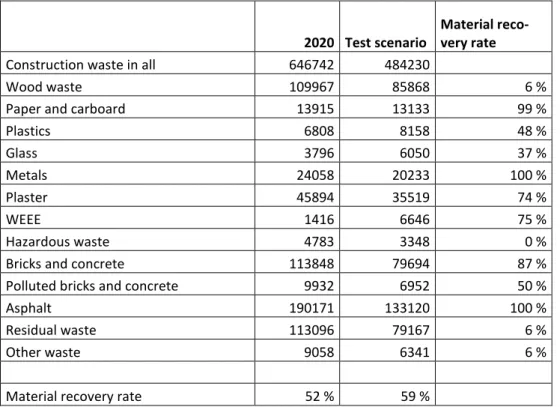
Drivers and barriers for prevention, reuse and recycling of C&D waste
A lack of knowledge within the sector of the legislation and legal requirements during demolition preparation is also seen as a barrier, especially among the small companies in the sector. Increasing knowledge of the possibilities of using recycled materials by architects and developers is seen as key to building resource-efficient buildings. The management of material on a construction site is generally the responsibility of the contractor managing the construction site, and the contractor seldom has any incentive to make the best possible use of waste materials.
Identifying potential uses outside the construction sector can help expand the market and drive demand, while temporary economic support can help mature the market. Uncertainty about the quality of the recycled material also acts as a barrier to further utilization, something that certification and CE labeling can help alleviate.
Recommendations for policy initiatives for better C&D waste management
- Waste Framework Direction (WFD)
- Landfilling directive
- Eco Design Directive, Construction Products Regulation (CPR) and Directive on the Energy
- Renovation Wave
- Economic instruments
- Better statistics for C&D waste
- Norwegian legislation
This could be extended to C&D waste where other fractions such as wood, concrete and brick, gypsum, asphalt could be added. Setting targets for C&D waste could be relevant for paper and cardboard, plastics, wood, glass, metals, concrete and plaster. As a general recommendation, NIRAS recommends that the same regulations be developed for building and construction waste as for municipal waste.
All regulations and targets set in WFD for MWE must also be applied for C&D waste. However, as far as NIRAS understands the proposal, the ban is limited to separately collected C&D waste.
List of literature
